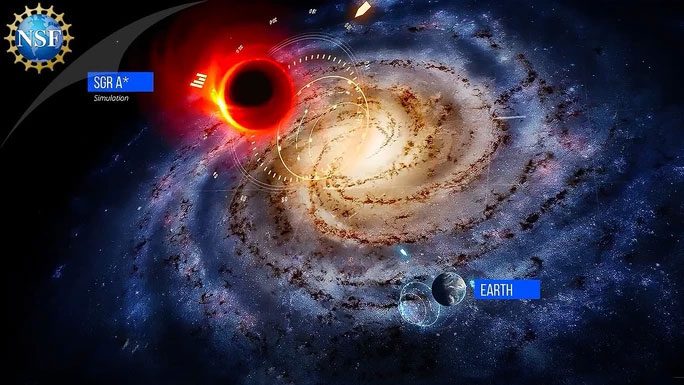A new study targeting the closest supermassive black hole to us reveals chilling signs that it is approaching the cosmic speed limit, causing spacetime to twist accordingly.
Supermassive black holes are colossal black holes, typically found at the centers of galaxies. The black hole under study is Sagittarius A*, the “heart” of the Milky Way galaxy that contains Earth.
A team of scientists from Pennsylvania, led by physicist Ruth A. Daily, utilized NASA’s Chandra X-ray Observatory to observe the X-rays and radio waves emitted from the material flowing into Sagittarius A*.

Graphic depicting the Sagittarius A* black hole (Sgr A*), Milky Way, and Earth – (Image: NSF).
They found that the rotation speed of this black hole is extremely fast, with a spin parameter ranging from 0.84 to 0.96, nearing the “cosmic speed limit” defined based on the diameter of the black hole.
The rotation of a black hole differs from that of other cosmic objects.
While planets, stars, and asteroids are solid objects with physical surfaces, a black hole is essentially a region of spacetime bounded by a non-physical surface known as the “event horizon,” from which no light can escape.
The immense gravitational pull of the black hole affects its spin, influencing the surrounding areas and creating a region called the ergosphere, where spacetime is highly curved and twisted.
This is also what allows scientists to “see” the black hole. Although it is invisible, the way spacetime changes causes light from objects passing through the area around it to be distorted, indicating its existence.
Moreover, the rapid rotation of the supermassive black hole Sagittarius A* suggests that it is a glutton, even though it is currently mostly inactive. The black hole accelerates and grows as matter falls into it. Additionally, the environment around the black hole, such as the accretion disk, can affect its motion.
With the recorded speed, Sagittarius A*—with a mass equivalent to only 4.5 million Suns—is astonishing, as it is considered the hungriest black hole at the center of the supermassive galaxy M87, which has a spin parameter of only about 0.89 to 0.91, despite its mass being 6.5 billion Suns.




















































